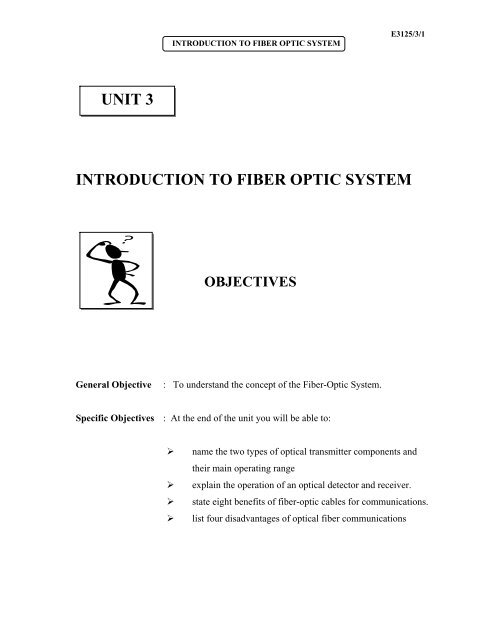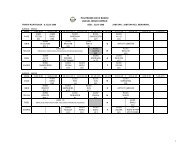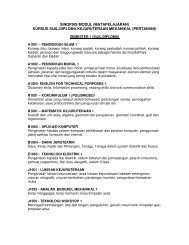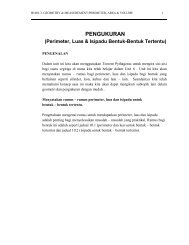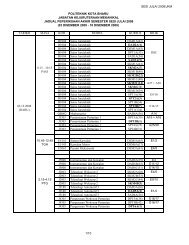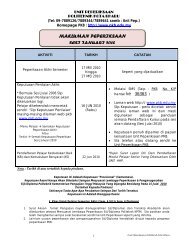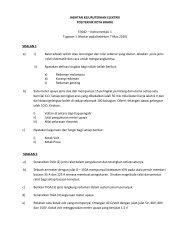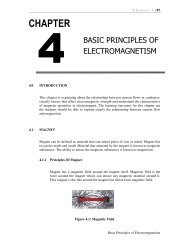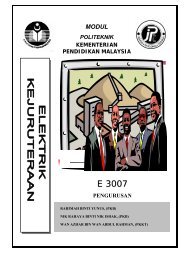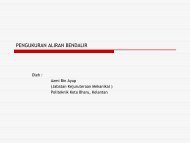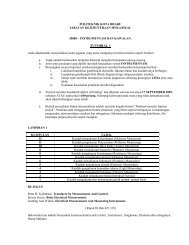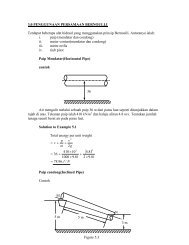INTRODUCTION TO FIBER OPTIC SYSTEM UNIT 3
INTRODUCTION TO FIBER OPTIC SYSTEM UNIT 3
INTRODUCTION TO FIBER OPTIC SYSTEM UNIT 3
Create successful ePaper yourself
Turn your PDF publications into a flip-book with our unique Google optimized e-Paper software.
<strong>INTRODUCTION</strong> <strong>TO</strong> <strong>FIBER</strong> <strong>OPTIC</strong> <strong>SYSTEM</strong>E3125/3/1<strong>UNIT</strong> 3<strong>INTRODUCTION</strong> <strong>TO</strong> <strong>FIBER</strong> <strong>OPTIC</strong> <strong>SYSTEM</strong>OBJECTIVESGeneral Objective: To understand the concept of the Fiber-Optic System.Specific Objectives : At the end of the unit you will be able to:‣ name the two types of optical transmitter components andtheir main operating range‣ explain the operation of an optical detector and receiver.‣ state eight benefits of fiber-optic cables for communications.‣ list four disadvantages of optical fiber communications
<strong>INTRODUCTION</strong> <strong>TO</strong> <strong>FIBER</strong> <strong>OPTIC</strong> <strong>SYSTEM</strong>E3125/3/2INPUT3.0 IntroductionDo you know that, themost widely used lightsources in fiber-opticsystems is the injectionOf course! It is becauseILD can produce a lowlevelforward biascurrent or a brilliantlight over a muchnarrower frequencyrange at threshold.An optical communications system begins with the transmitter, which consists of amodulator and the circuitry that generate the carrier. The carrier is a light beam thatis modulated by the digital pulses which turn it on and off. Generally, the basictransmitter is nothing more than a light source. Whereas the receiver part of theoptical communications system is relatively simple. It consists of a detector that willsense the light pulses and convert them into an electrical signal. This signal is thenamplified and shaped into the original serial digital data.
<strong>INTRODUCTION</strong> <strong>TO</strong> <strong>FIBER</strong> <strong>OPTIC</strong> <strong>SYSTEM</strong>E3125/3/33.1 Light SourcesGenerally, a light source must meet the following requirements:• It must be able to turn on and off several tens of millions, or even billions, oftimes per second.• It must be able to emit a wavelength that is transparent to the fiber.• It must be able to couple light energy into the fiber.• The optical power emitted must be sufficient enough to transmit throughoptical fibers.• The performance of the fiber-optic should not be affected by the temperaturevariation.• The manufacturing cost of the light source must be relatively inexpensive.There are two types of light sources used by light wave equipment for optical fibertransmission, light-emitting diodes ( LEDs ) and Injection laser diode (ILD).LED is an incoherent light source that emits light in a disorderly way as compared toILD, which is a coherent light source that emits light in a very orderly way (seeFigure 3.1).Incoherent radiation(a)Coherent radiation(b)Figure 3.1Radiation patterns for (a) LED ; (b) ILDLEDs are economical and are common for short distance,low data rate applications. They are available for all threewavelengths but are most common at 850 and 1310 nm
<strong>INTRODUCTION</strong> <strong>TO</strong> <strong>FIBER</strong> <strong>OPTIC</strong> <strong>SYSTEM</strong>E3125/3/4( 850 nm LEDs are usually the least expensive ). Light power from an LED covers abroad spectrum, from 20 to over 80 nm . The LED is more stable and reliable than alaser in most environments.Injection Laser Diodes are more expensive. The advantagesof using a laser diode are in the high modulation bandwidth( over 2 GHz ), with high optical output power and narrowspectral width. Their application is in long distance, high data rate requirements.Lasers are common in single mode optical fiber applications and their light powercovers a very narrow spectrum, usually less than 3 nm. This results in a lowchromatic dispersion value and hence high fiber bandwidth. Their life span is shorterthan that of an LED. Lasers are sensitive to the environment (especially totemperature variation).PRECAUTION!!!!!Optical output from a laser is strong and can easily damage the eye.Never look into laser light or a fiber coupled to a laser. Ensure that allLaser sources are powered off before disconnecting the fibers.
<strong>INTRODUCTION</strong> <strong>TO</strong> <strong>FIBER</strong> <strong>OPTIC</strong> <strong>SYSTEM</strong>E3125/3/53.2 Light DetectorOptical detection occurs at the light wave receiver’s circuitry. The photo detector isthe device that receives the optical fiber signal and converts it back into an electricalsignal. The most important characteristics of light detectors are :1. Responsitivity: Responsitivity is a measure of the conversion efficiency of aphotodetector.2. Dark current: Dark current is the leakage current that flows through aphotodiode with no light input.3. Transit time: Transit time is the time it takes a light-induced carrier to travelacross the depletion region.4. Spectral response: Spectral response is the range of wavelength values thatcan be used for a given photodiode.5. Light sensitivity: Light sensitivity is the minimum optical power a lightdetector can receive and still produce a usable electrical output signal.The most common types of photo detectors are the positive intrinsic negativephotodiode ( PIN ) and the avalanche photodiode (APD ).PIN photodiodes are inexpensive, but they require a higher optical signal power togenerate an electrical signal. They are more common in short distancecommunication applications.The APD photodiodes are more sensitive to lower optical signal levels and can beused in longer distance transmissions. They are more expensive than the PINphotodiodes and are sensitive to temperature variations.Both photodiodes can operate at similar, high-signal data rates. Some receiver photodetector circuits operate within a narrow optical dynamic range.
<strong>INTRODUCTION</strong> <strong>TO</strong> <strong>FIBER</strong> <strong>OPTIC</strong> <strong>SYSTEM</strong>E3125/3/6With sufficient Input fromthe unit, is time to do someexercises. Let me start withthe example…Example 3.1Give two types of light sources and light detectors that are used in fiber-opticsystems.Solution to Example 3.1The light sources are: LEDs and ILD.The light detectors are: positive intrinsic negative photodiode (PIN) and theavalanche photodiode (APD).
<strong>INTRODUCTION</strong> <strong>TO</strong> <strong>FIBER</strong> <strong>OPTIC</strong> <strong>SYSTEM</strong>E3125/3/7Activity 3ATEST OUR UNDERSTANDING BEFORE YOU CONTINUE WITH THENEXT INPUT…!3.1 Light travels in a ....a Circle. b. Straight line. c. Curve. d. Random way.3.2 Which is faster, an LED or ILD ? _______3.3 Which produces the brightest light , an LED or ILD ? ________3.4 The most sensitive and fastest light detector is the____________________________.Don’t forget to compareyour answers with thefeedback on the nextpage.
<strong>INTRODUCTION</strong> <strong>TO</strong> <strong>FIBER</strong> <strong>OPTIC</strong> <strong>SYSTEM</strong>E3125/3/8Feedback To Activity 3A3.1 b3.2 ILD3.3 ILD3.4 Avalanche photodiodeIt is too easy, isn’t it?Go to the second inputand see how much youcan remember.
<strong>INTRODUCTION</strong> <strong>TO</strong> <strong>FIBER</strong> <strong>OPTIC</strong> <strong>SYSTEM</strong>E3125/3/9INPUT3.3 The Advantages of Fiber-Optic Communications systemThe advantages of fiber-optic systems warrant considerable attention. This newtechnology has clearly affected the telecommunications industry and will continue tothrive due to the numerous advantages it has over its copper counterpart.The major advantages include:BandwidthOne of the most significant advantages of fiber over copper or other transmissionmedia is the bandwidth. Bandwidth refers to the range of frequencies which a cablewill carry. The advanced fiber-optic systems transmit several gigabytes per secondover hundreds of kilometers. Thousands of voice channels can now be multiplexedtogether and sent over a single fiber strand.Less LossCurrently, fiber is being manufactured to exhibit less than a few tenths of a decibelof loss per kilometer. Imagine glass so pure that you could see through a windowover 75 miles (120 km) thick. Repeaters can now be spaced 50 to 75 miles apartfrom each other.Noise Immunity and SafetyBecause fiber is constructed of dielectric materials, it is immune to inductivecoupling or crosstalk from adjacent copper or fiber channels. In other words, it is not
<strong>INTRODUCTION</strong> <strong>TO</strong> <strong>FIBER</strong> <strong>OPTIC</strong> <strong>SYSTEM</strong>E3125/3/10affected by electromagnetic interference (EMI) or electrostatic interference. Thisincludes environments where there are electric motors, relays, and even lightning.Likewise, because fiber optic cables transmit light instead of current link, they useuseful areas where EMI must be kept to a minimum. With the telecommunicationshighways of the air as congested as they are, the use of fiber is an attractivealternative.Less Weight and VolumeFiber optic cables are substantially lighter in weight and occupy much less volumethan copper cables with the same information capacity. Fiber optic cables are beingused to relieve congested underground ducts in metropolitan and suburban areas. Forexample, a 3-in. diameter telephone cable consisting of 900 twisted-pair wires can bereplaced with a single fiber strand 0.005 in. in diameter (approximately the diameterof a hair strand) and retain the same information carrying capacity. Even with arugged protective jacket surrounding the fiber, it occupies enormously less space andweighs considerably less.SecurityBecause light does not radiate from a fiber optic cable, it is nearly impossible tosecretly tap into it without detection. For this reason, several applications requiringcommunications security employ fiber-optic systems. Military information, forexample, can be transmitted over fiber to prevent eavesdropping. In addition, metaldetectors cannot detect fiber-optic cables unless they are manufactured with steelreinforcement for strength.FlexibilityWe normally think of glass as being extremely brittle. If one were to attempt to benda 1/8-in. thick glass window, it would certainly break at the same point. One reasonis that the glass we are familiar with has a considerable amount of surface flaws,although it appears polished. The outer surface of the glass would bend considerablymore than the inside. The surface flaws would initiate the crack in the same manner
<strong>INTRODUCTION</strong> <strong>TO</strong> <strong>FIBER</strong> <strong>OPTIC</strong> <strong>SYSTEM</strong>E3125/3/11that long scratches are intentionally used to crack and form glass windows. Thesurface of glass fiber is much more refined than ordinary glass. This, coupled with itssmall diameter, allows it to be flexible enough to wrap around a pencil. In terms ofstrength, if enough pressure is applied against it, a 0.005-in. strand of fiber is strongenough to cut one ‘s finger before it breaks.EconomicsPresently, since the cost of fiber is comparable to copper it is expected to drop as itbecomes more widely used. Because transmission losses are considerably less thanfor coaxial cable, expensive repeaters can be spaced farther apart. Fewer repeatersmean a reduction in overall system costs and enhanced reliability.ReliabilityOnce installed, a longer life span is expected with fiber over its metallic counterparts,because it is more resistant to corrosion caused by environmental extremes such astemperatures, corrosive gases, and liquids.3.4 Disadvantages of Fiber-Optic SystemIn spite of the numerous advantages that fiber-optic systems have over conventionalmethods of transmission, there are some disadvantages, particularly because of itsnewness. Many of these disadvantages are being overcome with new andcompetitive technology. The disadvantages include:Interfacing CostsElectronic facilities must be converted in order to interface to the fiber. Often thesecosts are initially overlooked. Fiber-optic transmitters, receivers, couplers, andconnectors, for example, must be employed as part of the communication system.Test and repair equipment is costly. If the fiber-optic cable breaks, splicing can be
<strong>INTRODUCTION</strong> <strong>TO</strong> <strong>FIBER</strong> <strong>OPTIC</strong> <strong>SYSTEM</strong>E3125/3/12costly and tedious task. Manufacturers in this related field however are continuouslyintroducing new and improved field repair kits.StrengthOptical fiber , by itself has a significant lower tensile strength than coaxial cable.Surrounding the fiber with stranded Kevlar (A nonmetallic, difficult to-stretch,strengthening material) and a protective PVC jacket can help to increase the pullingstrength. Installations requiring greater tensile strengths can be achieved with steelreinforcement.Remote Powering Of DevicesOccasionally, it is necessary to provide electrical powerto a remote device. Because this cannot be achievedthrough the fiber, metallic conductors are often includedin the cable assembly. Several manufacturers now offer acomplete line of cable types, including cables manufactured with both copper wireand fiber.Inability to interconnectA disadvantage of the fiber-optic system is it's incompatibility with the electronichardware systems that make up today's world. This inability to interconnect easilyrequires that current communication hardware systems be somewhat retrofitted to thefiber-optic networks. Much of the speed that is gained through optical fibertransmission can be inhibited at the conversion points of a fiber-optic chain. When aportion of the chain experiences heavy use, information becomes jammed in abottleneck at the points where conversion to, or from, electronic signals is takingplace. Bottlenecks like this should become less frequent as microprocessors becomemore efficient and fiber-optics reach closer to a direct electronic hardware interface.
<strong>INTRODUCTION</strong> <strong>TO</strong> <strong>FIBER</strong> <strong>OPTIC</strong> <strong>SYSTEM</strong>E3125/3/13Example 3.2Name at least six advantages of using fiber.Solution to Example 3.2The six advantages are: bandwidth, less weight and volume, less loss, security,flexibility, safety.If you got the right answer for theexample, proceed to the followingactivity…
<strong>INTRODUCTION</strong> <strong>TO</strong> <strong>FIBER</strong> <strong>OPTIC</strong> <strong>SYSTEM</strong>E3125/3/14Activity 3BTEST OUR UNDERSTANDING BEFORE YOU CONTINUE WITH THENEXT INPUT…!3.5 Name at least two shortages of fiber-optic system.3.6 What is the meaning of coherent?3.7 The main benefit of fiber-optic cables than electrical cable is its______________________.
<strong>INTRODUCTION</strong> <strong>TO</strong> <strong>FIBER</strong> <strong>OPTIC</strong> <strong>SYSTEM</strong>E3125/3/15Feedback To Activity 3B3.5 Interfacing costs, strength.3.6 Coherent refers to the emits of light from ILD that is orderly (inphase).3.7 Wide bandwidth
<strong>INTRODUCTION</strong> <strong>TO</strong> <strong>FIBER</strong> <strong>OPTIC</strong> <strong>SYSTEM</strong>E3125/3/16KEY FACTS1 Laser: A coherent light source used as a transmitter in fiber-opticsystems.2 ILD: A semiconductor diode used as a transmitter for fiber-optic3 APD: A photodiode used as a receiver for fiber-opticcommunications and having a higher responsivity comparedwith the PIN photodiode.4 Repeater: Device that is used to regenerate the light signals that becometoo low after they travel long distances.
<strong>INTRODUCTION</strong> <strong>TO</strong> <strong>FIBER</strong> <strong>OPTIC</strong> <strong>SYSTEM</strong>E3125/3/17SELF-ASSESSMENTYou are approaching success. Try all the questions in this self-assessment sectionand check your answers with those given in the Feedback on Self-Assessment givenon the next page. If you face any problems, discuss it with your lecturer. Good luck.Question 3-1a. What does LASER stand for?b. Explain the difference between a PIN diode and an APD.c. What is the velocity of light in free-space?d. List 3 (THREE) primary characteristics of light detector.Question 3-2a. Name the 4 (FOUR) disadvantages of fiber-optic system.b. Briefly describe the methods use to overcome the above (a) mater.
<strong>INTRODUCTION</strong> <strong>TO</strong> <strong>FIBER</strong> <strong>OPTIC</strong> <strong>SYSTEM</strong>E3125/3/18Feedback To Self-AssessmentHave you tried the questions????? If “YES”, check our answers now.Answer 3.1a. A LASER is a coherent light source used as a transmitter in fiber-opticsystems.b. (i) It must be able to turn on and off several tens of millions, or even billion,of time per second.(ii) It must be able to emit a wavelength that is transparent to the fiber.(iii)It must be able to couple light energy into the fiber.c. The velocity of light in free space is 3 x 10 8 m/s.d. PIN photodiodes are inexpensive, but they require a higher optical signalpower to generate an electrical signal. They are more common in shortdistance communication applications. As for APD, it having a higherresponsivity compared with the PIN photodiode.Answer 3-2a. The 4 (FOUR) disadvantages are:i. Interfacing Costsii. Strengthiii. Remote Powering of Device, andiv. Inability to Interconnectb. (i) Interfacing costs are referring to the costly test and repair equipment,
<strong>INTRODUCTION</strong> <strong>TO</strong> <strong>FIBER</strong> <strong>OPTIC</strong> <strong>SYSTEM</strong>E3125/3/19(ii)(iii)(iv)as well as the technology needs. Manufacturer are continuouslyinventing and introducing new or improved field repair kits in order tobust the marketing with the cheaper material.Strength of the fiber-optic cable can be improved by steelreinforcement.Metallic conductors are often included in the fiber-optic cableassembly strengthen the cable.Microprocessors that are more efficient help the signals flow throughthe optical cable reach closer to a direct electronic hardware interface.CONGRATULATIONS !!!You have finished this unitsuccessfully.


